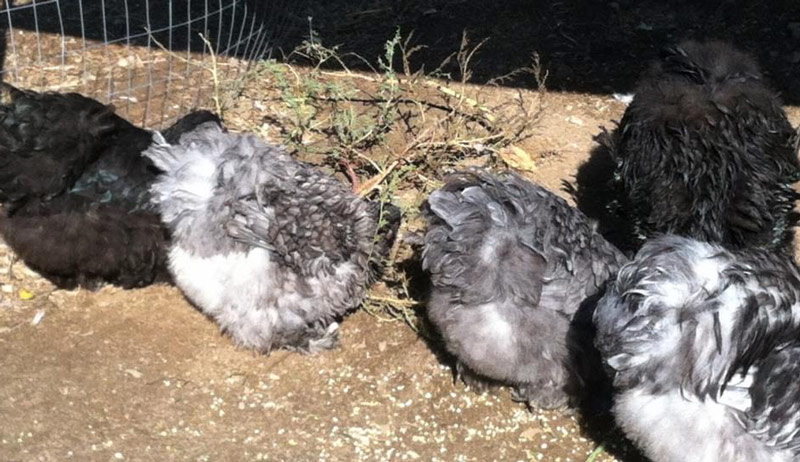
When my husband, Jae, and I started our poultry farm a couple of decades ago, we made the decision to raise heritage breeds that were on the Livestock Conservancy’s Conservation Priority List —in other words, breeds that were critically endangered or threatened. One breed, in particular, stood out for me: a large, feather-legged bird that came in a variety of colors and was supposedly one of the friendliest, most gentle breeds of poultry: the Cochin.
I searched for local Cochin breeders in my state and managed to find one about two hours west of us. Soon after, we were the proud owners of one dozen beautiful Cochin chicks.
Although years have passed since our original Cochins and their descendants passed on, if I were to convince Jae to add one more breed to our farm (which currently consists of Orpingtons and Ameraucanas, plus Ancona ducks), it would hands down be Cochins. Every single Cochin we raised—and we raised several dozen over the years—started out as a gentle chick, happy to be held, and only became more affectionate as an adult.
Our Cochins got along with every breed of chicken we raised, would contentedly follow us around as we did our poultry and yard chores, and would jump up onto our laps for petting and cuddles when given the opportunity. Aside from their affection, our Cochins were fabulous garden helpers, gobbling up insects and voraciously snacking on dandelions.
Despite their heavily feathered feet, they were expert scratchers, turning over mulch in our flower beds as they searched for grubs and other treats. Our Cochins were also our best winter layers, producing eggs right through the winter holidays despite the shorter daylight hours.
We aren’t the only ones infatuated with this beautiful breed of bird, however. Currently and in centuries past, Cochin has inspired everyone from the regular homeowner to royals to own poultry flocks.
A Bird Fit for a Queen
Keeping chickens was nothing new in the 1800s. Most of the fowl kept at that point were descendants of the Red Jungle Fowl, with few exceptions, and resembled your basic barnyard bird: small, slender, single comb, yellow shanks, red-brown feathers. Imagine the uproar when, in 1843, Captain Edward Belcher, a British Navy officer, presented the newlywed Queen Victoria with five hens and two roosters he had acquired during his travels through Asia.
These seven birds were unlike any chicken previously seen in Europe: tall, full bodied and with striking plumage. Victoria was enthralled and had a special aviary built for her “Cochin Chinas” at Windsor Castle. Soon other European royals were raising their own flocks from hatching eggs provided by the British queen.

Cochin Fever
The Victorian birds, however, bore little resemblance to today’s Cochin. The stout, feather-legged bird we know today took England by storm a few years after the arrival of the royal Cochin Chinas. A Mr. Moody and a Mr. Sturgeon both acquired sizable, feather-legged birds from China and began breeding what they called Shanghai Fowl.
The British public didn’t think much of the name, however. They insisted on calling these newcomers Cochins as well. Then, at the 1850 Birmingham Exhibition, these large, fluffy chickens made their official debut and astonished attendees. Word spread quickly of an immense chicken with a crow-like lion’s roar but affectionate as a pet.
The Cochin Craze quickly took hold throughout Great Britain, and America soon followed suit.
Also Read: These rare and unique heritage chickens are odd birds indeed!
Problematic Poultry
Despite being a favorite amongst fowl fanciers, there are some drawbacks to breeding this beautiful bird. For starters, the Cochin takes the scenic route to maturity, reaching the point of lay at about eight months (versus about four to five months for other breeds) and table size at age 16 months (versus six months for other dual-purpose birds).
Because of their size, Cochins tend to move much more slowly than other chickens, making them easy targets for ground-based predators. The Cochin’s size also inhibits its ability to reach high roosts inside the coop. Lower roosts are required.
Because of their heavy feathering, Cochins suffer in the high heat of summer and require shady spaces where they can cool off. Cochin hens also have a tendency to go broody, cutting back on their egg production, which typically averages 200 large brown eggs per year.
Beautiful Breeders
The Cochin’s proclivity towards setting eggs, however, is very much a positive for those looking to breed these gentle birds. Cochin hens make fabulous mothers. They will happily set and raise their own chicks as well as those from other breeds of poultry, even ducklings and turkey poults.
Cochin roosters have been known to help set eggs, too, and they make attentive fathers. Cochins are very cold hardy and thrive in the harshest of winter climates.
And then there’s the Cochin wow factor. Their abundance of soft, fluffy feathers adds to their immense appearance, with feathering extending down to their toes. Cochin tail feathers add to their appeal, as these feathers drape into a round bun form instead of the tall, extended tail feathers of other breeds. The American Poultry Association (APA) recognizes nine varieties of standard-fowl Cochin:
- Buff
- Partridge
- White
- Black
- Silver Laced
- Golden Laced
- Blue
- Brown
- Barred
However, there are many other unrecognized color varieties developed by poultry fanciers. There are even frizzle Cochins and, for backyard flock owners with limited space, bantam Cochins.
Jae and I bred and raised Blue, Black, White, Splash and Frizzle Cochins over the years on our farm. During that time, Cochin’s popularity experienced a resurgence across America, and the Livestock Conservancy considers the breed fully recovered from its previous endangered status. I would happily add Cochins back into our flock in a heartbeat. They are the breed I recommend the most to brand-new backyard flock keepers, families with small children, and basically anybody who wants to experience raising a beautiful bird.





